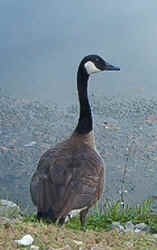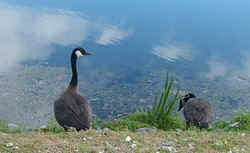 |
 |
Canadian Geese
Scientific Name: Branta canadensis
Family Name: Anatidae
Lake Hosea
Henderson County, North Carolina
August 14, 2002
 |
 |
The most common and best-known goose, identified by the black head and neck and broad white cheek. It breeds on lake shores and coastal marshes. Gathers in large flocks after the breeding season and grazes in open fields within commuting distance of water. Migrates by day and by night. There are at least ten recognized subspecies, which differ greatly in size and slightly in color. The characteristic honking is well known; the smaller races have a cackling call. [Robbins, Chandler S.; Bruun, Bertel and Zim, Herbert S., A Guide to Field Identification Birds of North America, Golden Press, New York, 1983]
Our most common and familiar goose. Black head and neck marked with distinctive white "chin strap" stretching from ear to ear. In flight, shows large, dark wings, white under tail coverts, white U-shaped rump band. Subspecies vary geographically in breast color, in general paler in eastern populations, darker in western; ranging from pale B.c. canadensis of the eastern seaboard to dark occidentalis of southern Alaska. Size decreases northward, with the smaller forms breeding on the high Arctic coastal tundra: pale-breasted hutchinsii in central and western Canada, and minima, smallest of all, in western Alaska. Endangered Aleutian subspecies, leucopareia, is distinguished from minima by slightly larger size, paler breast, and often a broad white neck ring; minima may show a very narrow ring. Canada Geese breed in open or forested areas near water. Flocks usually migrate in V-formation, stopping to feed in wetlands, grasslands, or cultivated fields. Call is a deep, musical honk-a-honk in larger forms, a rapid, high cackle in smaller ones. [National Geographic Society, Field Guide to the Birds of North America Second Edition, National Geographic Society, Washington, D.C., 1987]